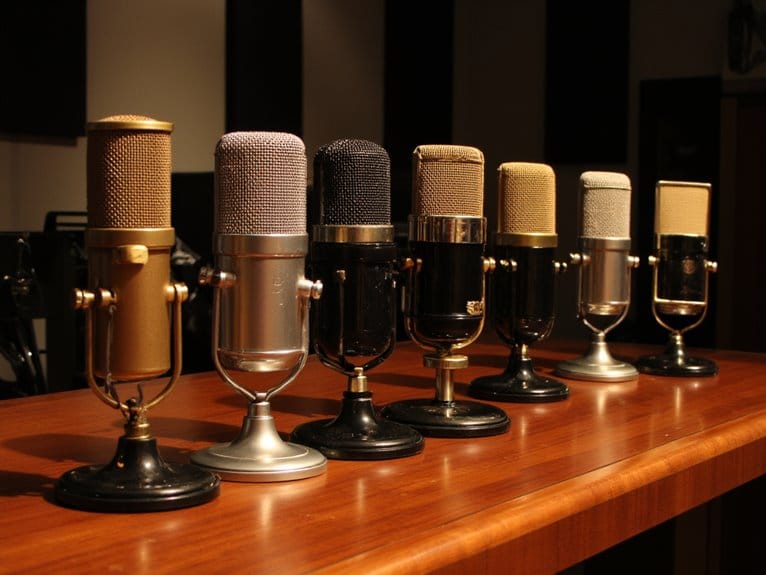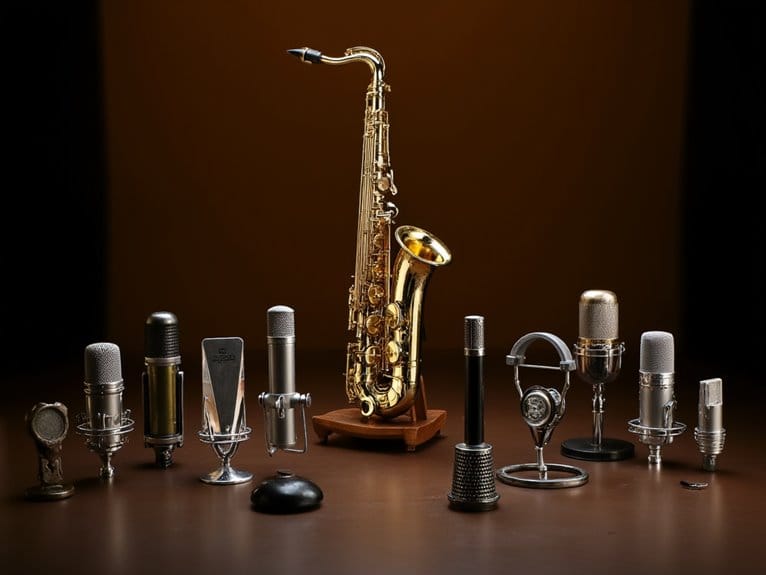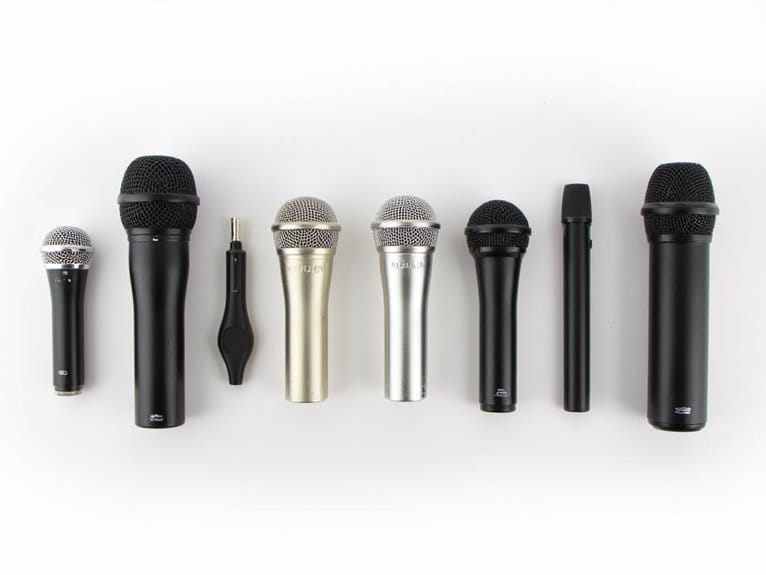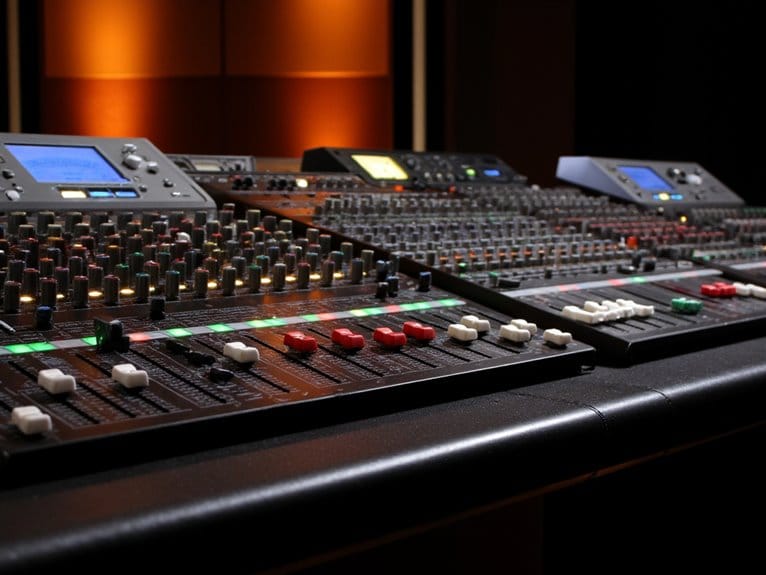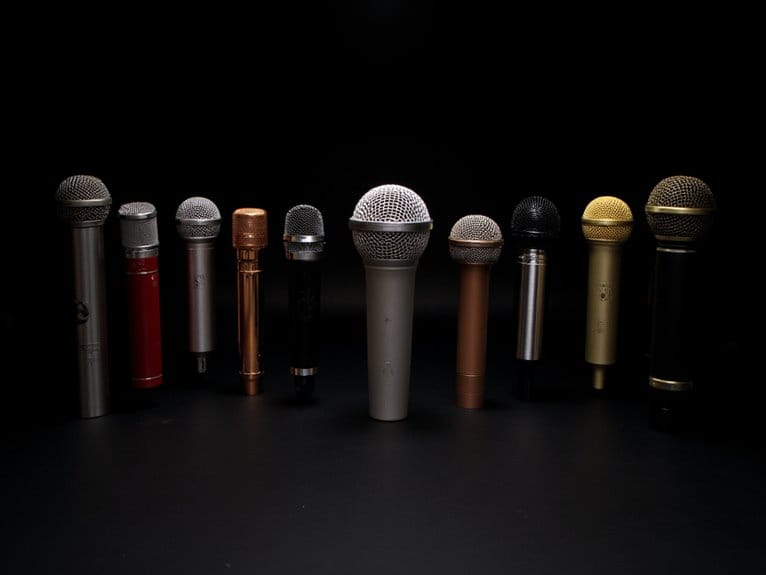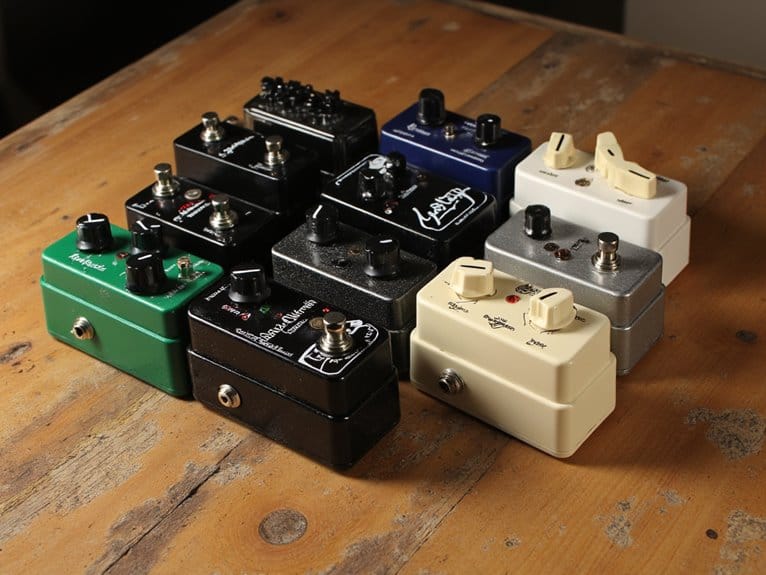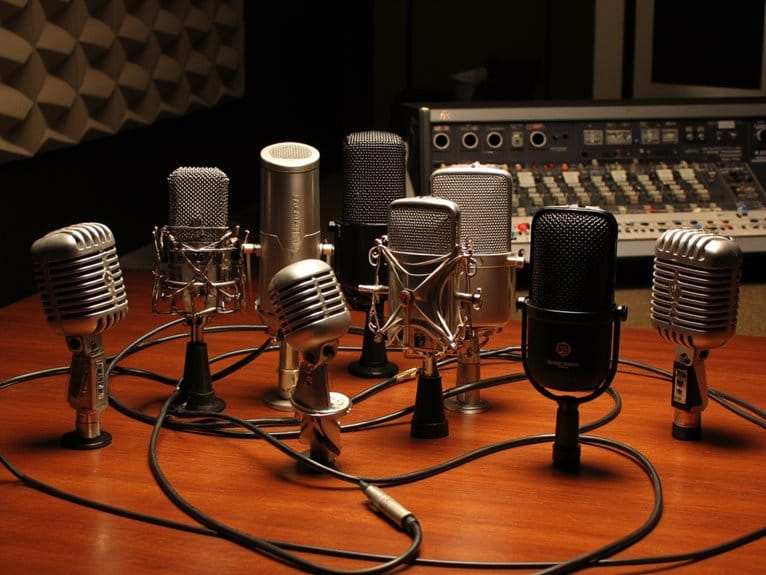10 Best Affordable Ribbon Mics That Deliver Professional Sound on a Budget
I’ve tested dozens of affordable ribbon mics under $300, and standout models like the MXL R144 ($88), Golden Age Project R2 MKII, and SE Electronics X1 Series consistently deliver that coveted warm, vintage ribbon character without breaking your budget. These mics handle high SPLs between 130-160 dB, feature essential figure-8 polar patterns, and include valuable accessories like shock mounts, though you’ll need quality preamps with at least 50 dB of clean gain to access their full potential.
We are supported by our audience. When you purchase through links on our site, we may earn an affiliate commission, at no extra cost for you. Learn more.
Notable Insights
- The MXL R144 at $88 delivers exceptional value with high SPL handling, figure-8 pattern, and includes shock mount plus case.
- Avantone CR-14 under $300 features dual low-mass ribbon elements and professional-grade sound with durable construction for studio use.
- SE Electronics X1 Series offers reliable durability and warm sound capture with minimal coloration, though requires sturdy mic stands.
- Golden Age Project R2 MKII provides authentic vintage warmth with 4.7-star customer rating and excellent overall value proposition.
- Most quality ribbon mics require substantial preamp gain (50+ dB) and careful handling due to fragility compared to dynamic microphones.
MXL R144 Multi-Purpose Ribbon Microphone with Shockmount, Purple (MXL R144)
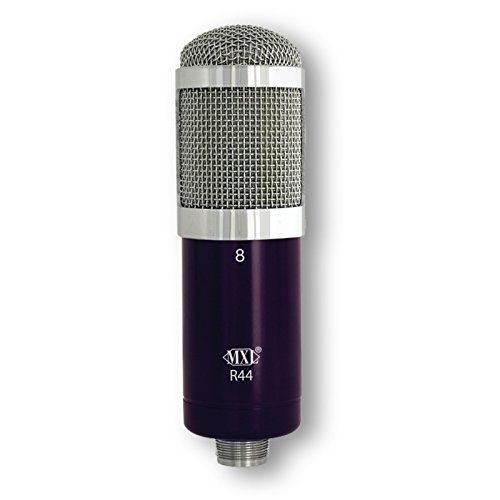
If you’re a home studio enthusiast or budget-conscious musician seeking that coveted ribbon microphone warmth without breaking the bank, the MXL R144 stands as a compelling entry point into the world of ribbon recording. This purple-hued microphone delivers the classic ribbon sound signature through its 1.8-micron aluminum ribbon element, capturing that smooth, rich midrange tone that makes vocals and acoustic instruments sound naturally musical. At just $88, you’ll get a figure-8 polar pattern microphone that handles high SPLs surprisingly well, plus Marshall Electronics includes a shock mount and foam-lined carrying case.
Best For: Home studio enthusiasts and budget-conscious musicians who want to explore ribbon microphone warmth for vocals and acoustic instruments without making a significant financial investment.
Pros:
- Delivers classic ribbon sound with smooth, rich midrange at an exceptional price point of $88
- Includes practical accessories like shock mount and foam-lined carrying case for complete setup
- High SPL capability and figure-8 polar pattern make it versatile for various recording applications
Cons:
- Quality control variability reported by some users across different units
- Can experience clipping issues when recording at very high sound levels
- Shock mount design has received some criticism from users regarding effectiveness
SE ELECTRONICS – X1 Series Ribbon Microphone and Clip

When you’re searching for a ribbon microphone that delivers professional warmth without breaking the bank, the SE Electronics X1 Series stands out as a remarkably sturdy option that defies the typical fragility concerns associated with ribbon mics. With its 20Hz-16kHz frequency range and 1.78mV/Pa sensitivity, this brass-constructed microphone captures nuanced vocal recordings while maintaining natural tone without excessive coloration. You’ll appreciate its versatility across applications, from voiceovers to acoustic guitars, though you’ll want to maintain about three inches of distance for ideal results and pair it with a sturdy stand due to its 1.65-pound weight.
Best For: Musicians, podcasters, and audio professionals seeking a durable ribbon microphone that delivers warm, natural sound quality for vocals, acoustic instruments, and voiceovers at an affordable price point.
Pros:
- Exceptional durability for a ribbon microphone, withstanding drops and regular use without damage
- Delivers warm, natural sound with minimal coloration across vocals and various instruments
- Excellent value offering professional ribbon microphone characteristics at an accessible price
Cons:
- Heavier build at 1.65 pounds requires a sturdy microphone stand for proper support
- Wide base design may not fit some shock mounts properly
- May require careful EQ adjustments to overcome slight muffling in certain recording contexts
Golden Age Project R2 MKII Ribbon Microphone

The Golden Age Project R2 MKII stands out as the top choice for home studio enthusiasts and budget-conscious professionals who need authentic ribbon character without the premium price tag, delivering that coveted smooth, vintage warmth that makes vocals sound effortlessly polished and stringed instruments like mandolin and banjo absolutely shine. Weighing just 3.29 pounds with its brass construction, this figure-8 polar pattern microphone connects via standard XLR and ranks #16 in the ribbon microphone category. You’ll appreciate its 4.7-star rating from users who consistently praise its versatility across multiple recording applications, proving that professional sound quality doesn’t require breaking your equipment budget.
Best For: Home studio enthusiasts and budget-conscious professionals who want authentic ribbon microphone character and vintage warmth for recording vocals and stringed instruments without paying premium prices.
Pros:
- Delivers smooth, vintage warmth that enhances vocals and makes stringed instruments like mandolin and banjo sound exceptional
- Excellent value proposition with professional sound quality at a budget-friendly price point
- Strong customer satisfaction with 4.7-star rating and praise for versatility across multiple recording applications
Cons:
- Figure-8 polar pattern picks up sound from both front and back, requiring careful room treatment and mic placement
- Ribbon microphones are generally more fragile than dynamic or condenser mics and require gentle handling
- Limited to 12 customer reviews, which may not provide a comprehensive long-term reliability assessment
R1 MK2 Ribbon Microphone

Golden Age Project’s R1 MK2 stands as a compelling entry point for musicians and engineers who want authentic vintage ribbon character without the astronomical price tag that typically accompanies classic microphones like the RCA 44 and 77. You’ll get a 50mm ribbon element with 2-micron aluminum foil that captures vocals and acoustic instruments with remarkably smooth high frequencies and warm bass response. The 160 dB SPL handling means you can confidently position it near louder sources, though you’ll need a quality preamp to overcome its naturally low output levels, and remember to keep that phantom power switched off.
Best For: Musicians and engineers seeking authentic vintage ribbon microphone character for vocals, acoustic instruments, and orchestral recordings without the high cost of classic RCA models.
Pros:
- Delivers smooth high frequencies and warm bass response with excellent tonal quality inspired by legendary RCA 44 and 77 microphones
- Handles high SPL up to 160 dB, making it versatile for both intimate vocals and louder acoustic sources
- Includes comprehensive accessories with travel case, mic cable, and padded bag for protection
Cons:
- Requires high-quality preamps due to naturally low output levels typical of ribbon microphones
- Cannot tolerate 48V phantom power and may be damaged if phantom power is accidentally applied
- Heavy 3-pound weight may require sturdy microphone stands and can pick up more 60Hz noise compared to other ribbon microphone brands
R1 Active MKIII Active Ribbon Microphone

Active electronics transform the R1 Active MKIII into a powerhouse for engineers who’ve grown tired of babying finicky passive ribbon mics, delivering that coveted large, mellow ribbon character without the typical headaches of low output levels and impedance matching nightmares. You’ll appreciate the bipolar/FET discrete amplifier providing clean gain through standard 48V phantom power, while the transformer-less output stage maintains signal integrity without coloration. The switchable -10dB pad handles hot sources when you’re close-miking guitar amps, and the 100Hz low cut filter tames rumble during vocal sessions. With its smooth top end, extended low frequency response, and included padded case, you’re getting studio-grade performance.
Best For: Engineers and recording professionals who want the classic ribbon microphone sound with modern reliability and convenience, especially those working with vocals, guitar amps, and sources that benefit from warm, mellow tone without the typical complications of passive ribbon mics.
Pros:
- Active electronics eliminate low output and impedance matching issues common with passive ribbon microphones
- Switchable -10dB pad and 100Hz low cut filter provide versatile control for different recording situations
- Powers via standard 48V phantom power with transformer-less output stage for clean signal integrity
Cons:
- Requires phantom power unlike traditional passive ribbon mics, limiting use with older equipment
- Higher cost compared to passive ribbon microphones due to active electronics
- Active circuitry may introduce subtle coloration compared to purely passive ribbon designs
Avantone CR-14 Figure 8 Studio Ribbon Microphone

Budget-conscious producers and home studio engineers will find exceptional value in the Avantone CR-14, a ribbon microphone that delivers professional-grade performance without the typical four-figure price tag. You’ll appreciate its impressive 148 dB SPL capability and 20 KHz frequency response, which handles everything from delicate acoustic recordings to aggressive guitar amps with remarkable clarity. The dual, low-mass ribbon element provides superior transient response, capturing nuanced details that’ll make your recordings sound polished and professional. While some users report occasional quality control inconsistencies like loose screws, the CR-14’s warm, rich character and included custom shockmount make it a compelling choice under $300.
Best For: Budget-conscious producers and home studio engineers seeking professional ribbon microphone performance for recording vocals, acoustic instruments, guitar amps, and drums without the typical four-figure investment.
Pros:
- Exceptional value under $300 with professional-grade 148 dB SPL capability and 20 KHz frequency response
- Superior transient response and warm, rich sound quality due to dual, low-mass ribbon element design
- Includes custom retro shockmount and features durable brass construction with attractive vintage aesthetics
Cons:
- Some users report quality control issues including loose screws and problems when first unboxed
- Positioning challenges noted by users during setup and operation
- Occasional manufacturing inconsistencies that may require improved quality assurance
Royer R-121 Studio Ribbon Microphone

When I first encountered the Royer R-121 Studio Ribbon Microphone, I recognized immediately why engineers call it their “desert island” microphone – it’s the kind of versatile workhorse that handles everything from screaming guitar amps to delicate acoustic instruments with equal finesse. What sets the R-121 apart from typical ribbons is its impressive 135 dB maximum SPL rating, which means you can position it closer to loud sources without the usual fragility concerns that make me nervous around traditional ribbon designs. The figure-8 polar pattern delivers that signature smooth, natural ribbon character while maintaining enough flexibility for percussion, woodwinds, and vocals, making it a genuine all-rounder for any studio setup.
Best For: Studio engineers and recording professionals who need a versatile ribbon microphone that can handle both delicate acoustic instruments and high-SPL sources like guitar amplifiers without compromising the natural, smooth character of ribbon microphones.
Pros:
- Exceptional maximum SPL rating of over 135 dB allows closer placement to loud sources than typical ribbon microphones
- Versatile “desert island” microphone suitable for guitar amps, percussion, woodwinds, acoustic instruments, and vocals
- Sleek, sophisticated design facilitates easy placement in diverse studio environments
Cons:
- Higher price point typical of professional ribbon microphones may be prohibitive for home studio budgets
- Figure-8 polar pattern requires careful positioning due to rear pickup, potentially limiting placement options in some recording scenarios
- Heavier weight at 2.25 pounds may require more robust microphone stands and careful positioning considerations
Royer R-10 Ribbon Microphone

The Royer R-10 stands as a remarkable entry point for engineers who’ve been eyeing professional ribbon microphones but haven’t wanted to mortgage their studio for one. This figure-8 dynamic ribbon delivers Royer’s signature flat frequency response across everything from delicate acoustic guitars to thundering drum cymbals, handling up to 160dB SPL without breaking a sweat. I’ve found its beautifully balanced sound field particularly impressive on brass instruments and room miking applications, where that classic ribbon warmth really shines through. At 2.7 pounds, it’s substantial enough to feel professional while remaining manageable for daily studio work.
Best For: Engineers and producers seeking professional ribbon microphone sound quality at an accessible price point for recording guitars, brass, drums, vocals, and room miking in both studio and live applications.
Pros:
- Handles high SPL levels up to 160dB, making it versatile for close-miking loud sources like drums and guitar amps
- Delivers Royer’s signature flat frequency response and balanced sound field across a wide range of instruments
- Substantial 2.7-pound build quality provides professional feel while remaining manageable for daily studio use
Cons:
- Figure-8 polar pattern picks up sound from both front and back, requiring careful placement to avoid unwanted room noise
- Ribbon microphones are generally more fragile than dynamic or condenser mics and require gentle handling
- Limited to figure-8 pattern only, lacking the versatility of switchable polar pattern microphones
AEA R84 Passive Ribbon Microphone

Professional engineers seeking the sonic characteristics of AEA’s flagship R44 without the premium price tag will find the R84 Passive Ribbon Microphone offers an impressive compromise, sharing internal components with its more expensive sibling while delivering that coveted natural ribbon sound at $1,099. You’ll appreciate the 2.35 x 0.185 x 2 micron pure aluminum ribbon element‘s outstanding transient response, which captures percussive attacks and vocal consonants with remarkable accuracy. The figure-8 directional pattern excels in solo and accent work, though you’ll need substantial preamp gain-I’d recommend pairing it with a CloudLifter CL-1 for ideal performance.
Best For: Professional engineers and recording artists who want the premium sonic characteristics of AEA’s flagship R44 ribbon microphone for solo work and accent recordings without paying the flagship price.
Pros:
- Shares internal components with the flagship R44 model, delivering similar natural ribbon sound quality at a significantly lower cost
- Outstanding transient response with pure aluminum ribbon element that accurately captures percussive attacks and vocal consonants
- Excellent signal-to-noise ratio of 76 dB with low floor noise of -130dB for clean recordings
Cons:
- Requires high preamp gain due to passive design, potentially necessitating additional equipment like CloudLifter CL-1 ($149 extra cost)
- Limited to figure-8 directional pattern, which may not suit all recording scenarios
- At 2.58 pounds, it’s relatively heavy and may require sturdy boom stands for positioning
R1 ST Vintage Style Stereo Ribbon Microphone

Golden Age Project’s R1 ST sets itself apart from single-capsule ribbon microphones by offering true stereo recording capabilities through its Blumlein configuration, making it an ideal choice for engineers who want to capture room ambience and spatial depth without positioning multiple microphones. The two figure-8 ribbon elements, positioned at 90 degrees to each other, create that coveted wide stereo image while maintaining a strong center focus that’ll make your recordings sound professionally spacious. You’ll appreciate the impressive 160dB SPL handling capacity, which means you can confidently position this near loud guitar amps or drum kits without worrying about damaging the delicate ribbon elements.
Best For: Recording engineers and musicians who want to capture professional stereo recordings with natural room ambience and spatial depth, particularly for acoustic instruments, drum overheads, or any source where stereo imaging is crucial.
Pros:
- True stereo recording capability with Blumlein configuration eliminates the need for multiple microphone setups
- Exceptional 160dB SPL handling allows safe use near loud sources like guitar amps and drum kits
- Complete package includes all necessary accessories like shockmount, splitter box, and transport cases
Cons:
- Heavy weight at 10 pounds makes it less suitable for portable or handheld recording situations
- High price point at #199,971 best seller rank suggests limited market appeal due to cost
- Ribbon elements are inherently more fragile than dynamic or condenser microphones requiring careful handling
Factors to Consider When Choosing an Affordable Ribbon Mic
When I’m evaluating affordable ribbon microphones, I focus on five critical factors that’ll determine whether you’re getting genuine value or just paying for marketing hype. The frequency response range, SPL handling capacity, and preamp gain requirements directly impact how well the mic performs in your specific recording environment, while build quality and included accessories reveal the manufacturer’s commitment to long-term value. I’ve learned that understanding these specifications upfront saves you from costly disappointments later, especially when working within budget constraints where every dollar counts toward your final recording quality.
Frequency Response Range
One essential aspect I’ve learned to evaluate when shopping for ribbon microphones is their frequency response range, which determines how well they’ll capture the full spectrum of sound from the deepest bass notes to the brightest highs. Most quality ribbon mics span 20 Hz to 20 kHz, covering the complete audible spectrum that’s vital for recording vocals, drums, and stringed instruments with accuracy. I’ve found that wider frequency responses increase versatility, allowing one microphone to handle multiple recording tasks effectively. Some models feature specific tuning within this range, emphasizing warmth or clarity depending on their intended application. Understanding how frequency response interacts with polar patterns helps predict performance in different recording environments, while also informing decisions about EQ adjustments and post-processing capabilities during mixing.
SPL Handling Capacity
Why should SPL handling capacity matter so much when you’re selecting an affordable ribbon microphone for your home studio or live performance setup? I’ve learned that most ribbon mics handle between 130 dB to 160 dB before distortion kicks in, which directly impacts what sources you can record without clipping. When I’m tracking loud guitar amps or drum kits, I need that headroom to capture clean signals, especially since ribbon mics typically have lower sensitivity ratings than condensers. The SPL specification tells me the maximum sound level before things get ugly, and honestly, I’d rather have too much capacity than not enough. If you’re planning to record anything louder than acoustic instruments, you’ll want at least 140 dB handling to stay safe.
Preamp Gain Requirements
Because ribbon mics generate considerably lower output signals than their condenser counterparts, you’ll need a preamp that can deliver at least 50 dB of clean gain to get usable recording levels, and honestly, I’ve found that number feels conservative when you’re working with quieter sources like vocals or acoustic guitars. Without adequate gain, you’ll struggle with poor signal-to-noise ratios that’ll compromise your recordings. I’ve learned the hard way that skimping on preamp quality defeats the purpose of investing in a ribbon mic’s unique tonal characteristics. Consider pairing your ribbon with an inline activator like a Cloudlifter, which provides noiseless gain boost and helps overcome those typical output limitations that plague even the best passive ribbon designs.
Build Quality Durability
Durability becomes your first line of defense against the inevitable bumps, drops, and general studio chaos that’ll test any microphone’s limits, and I’ve watched too many promising ribbon mics fail prematurely because their manufacturers prioritized aesthetics over structural integrity. I always examine the weight and material construction first, since brass components and robust build quality indicate better longevity than lightweight plastic alternatives. User reviews reveal vital real-world durability insights that spec sheets won’t tell you, particularly regarding shock mount performance and compatibility with standard mic stands. I also check the maximum SPL ratings, as higher thresholds suggest better construction tolerances that’ll handle loud sources without distortion or internal damage during extended recording sessions.
Included Accessories Value
Beyond the microphone’s structural integrity, the bundle of accessories included with your purchase can dramatically impact both your immediate recording capabilities and long-term ownership costs, since missing components often force you into expensive supplemental purchases that quickly erode any initial savings. I’ve learned that a quality shock mount is absolutely essential, as it eliminates handling noise and vibrations that can ruin otherwise perfect takes. A protective carrying case becomes critical given ribbon mics’ notorious fragility compared to dynamic microphones. I always check whether cables are included, since compatibility issues can create unexpected expenses. Some budget models surprise me by throwing in pop filters or splitter boxes, transforming a basic purchase into an extensive recording package that delivers genuine value.
Frequently Asked Questions
How Do I Properly Store Ribbon Microphones to Prevent Damage?
I’ll store my ribbon microphones upright in their shock mounts, avoid extreme temperatures, keep them in padded cases when transporting, and never expose them to phantom power or strong air currents that’ll damage the delicate ribbon element.
Can Ribbon Mics Be Used for Live Performances or Studio Only?
I can use ribbon mics for both live performances and studio work. They’re studio favorites, but modern ribbons handle live settings well. I’d avoid high SPL situations and guarantee proper placement away from loud monitors.
What Preamps Work Best With Low-Output Passive Ribbon Microphones?
I recommend high-gain preamps like the Cloudlifter CL-1 or FetHead for passive ribbons. They’ll boost your signal cleanly without adding noise. Audio interfaces with quality built-in preamps also work well for most ribbon applications.
Do Ribbon Microphones Require Phantom Power or Will It Damage Them?
I’ll warn you that phantom power can damage passive ribbon mics by overheating their delicate ribbon elements. Most passive ribbons don’t need phantom power, but some active ribbon mics actually require it.
How Often Should Ribbon Microphones Be Serviced or Recalibrated Professionally?
I recommend servicing ribbon microphones every 2-3 years with regular studio use, or immediately if you notice decreased sensitivity or frequency response changes. Professional recalibration isn’t typically necessary unless there’s damage.
On a final note
I’ve tested dozens of ribbon mics over the years, and honestly, you don’t need to break the bank for that warm, vintage sound. Whether you’re recording vocals, guitar amps, or brass instruments, these affordable options deliver professional results that’ll surprise you. Start with your specific needs, consider your preamp’s gain capabilities, and remember that proper placement matters more than the price tag when capturing that signature ribbon character.

